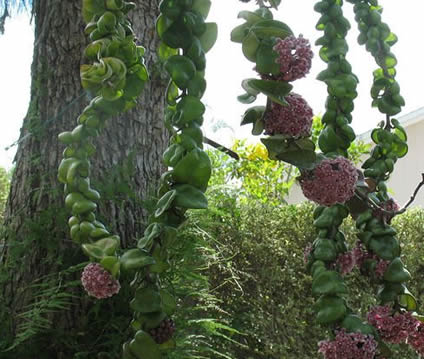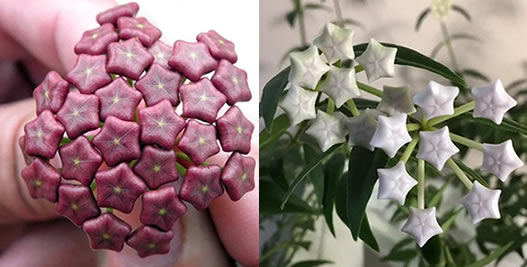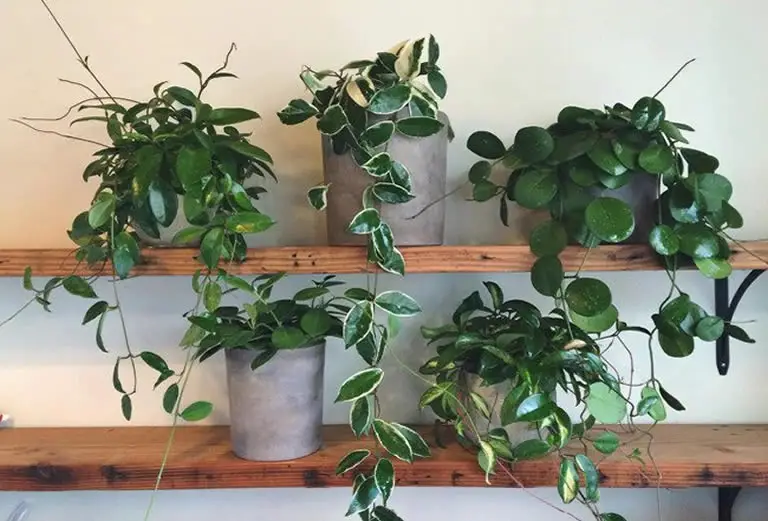There are hundreds of different species of Hoya, many of which are grown as houseplants. As an easy-care succulent to grow the Hoya plant requires much less attention than many other popular indoor plants. In this article I will cover how Hoya grows and the simple steps you can take to make your Hoya grow better, bigger and fuller with more abundant, vibrant blooms.
Table of Contents
- How Hoya Plants Grow
- How To Make Hoya Plants Grow Better
How Hoya Plants Grow
Although there are a small number of Hoya that grow in Central America, the vast majority of Hoya are Asian plants. They grow in Northern Australia, India and Eastern Asia.
Hoya are tropical succulents that are epiphytic, which simply means they are plants that require another plant to grow. For example, it is common to see Hoya, such as the Hindu Rope Plant, in their natural environment hanging from trees.
The Hindu rope plant below can be seen hanging from a tree after growing in one of its crevices.

Being a tropical semi-succulent Hoyas like warm temperatures and high humidity but being epiphytic they have some slightly different care requirements to the usual succulent, especially when grown as a houseplant.
Below I will outline the basic requirements you must give a Hoya so that it can exhibit healthy growth.
After reading this article you may also want to check out my article how to grow Hindu rope plant from cutting or seed as it has some insights and tips for growing your own Hoya carnosa compacta, or other Hoya plant as the instructions can be applied to growing all Hoya species.
The best soil that Hoya grow in
Hoya, being an epiphytic plant, requires soil that is that is light but also airy. The need for a fast-draining soil makes regular houseplant potting mixes unsuitable for Hoya and the need for good airflow in the soil makes regular succulent soil equally unsuitable.
As the plant naturally grows on other plants it has evolved roots that require much more airflow than most other succulents commonly grown in homes. Because it also grows on other plants rather than in terrestrial soil it needs good airflow to the roots.
The need to create both fast water drainage and the promotion of good airflow to the roots means we need a special type of soil for Hoyas.
First off, to ensure a Hoya’s roots do not end up sitting in water a Hoya houseplant must have a fast-draining soil.
As regular composts and potting mixes will naturally hold onto more moisture than is healthy for a Hoya, these type of soils on their own are not suitable. However, they do have the nutrients needed to feed Hoya.
Succulent soil is fast draining and will have enough nutritional value to feed a Hoya but most of these soils contain sand, or similar, which greatly restricts airflow.
So, the best soil for a Hoya will mimic succulent soil to a degree but it must also include a substance that promotes good airflow and also contain the proper levels of nutrients for healthy plant growth.
The following mix is the best type of soil for Hoya growth:
- 1 third potting mix.
- 1 third perlite.
- 1 third pumice or oak bark, or similar stuff.
Using just potting mix alone or succulent mix alone will restrict the growth of a Hoya plant. Don’t be tempted to take short cuts and use only one of those.
Also do not substitute potting mix with succulent soil. As I mentioned above succulent soil mixes have sand in them that is detrimental to the growth of Hoya.
Hoya may be semi-succulents but that doesn’t mean they like full sun
So what type of light do Hoya plants like?
Hoyas like shade. Hoyas do not like full sun. However, a Hoya grows best in strong indirect light. If grown in shade a maximum of 80% shade should be used. Never grow a Hoya in direct sunlight.
The Hoya grows in the shade of the larger plants it grows on so it has not evolved to handle strong direct sunlight.

Being a tropical plant the areas where Hoya grows naturally experience strong indirect light even in the shade. So although Hoya grows wildly in the shade it gets lots of indirect light.
This means a Hoya houseplant must get strong indirect light to grow properly.
Try to give your Hoya at least 6 hours of good indirect light per day, though 4 hours minimum is a must.
You can read more about the light requirements of Hoya plants in our Hindu rope plant care guide; Hindu rope plant is the Hoya species Hoya carnosa compacta.
Hoya plants need fertilizer when grown indoors
Along with the correct soil and the right type of light do Hoya also require fertilizing?
Hoya houseplants do need fertilizer. I have found that fertilizing the plant every 2 weeks during growing season helps the plant grow faster and fuller while promoting more blooms. A nitrogen rich fertilizer is advised though always make up any fertilizer to half strength only.
Hoya grow better in nitrogen-rich soil and the nitrogen in the soil in a houseplant pot or hanging basket can quickly become depleted. So, it is always a good idea to use either a nitrogen-rich fertilizer or add some nitrogen to whatever fertilizer you are using.
It can be challenging to get a high quality nitrogen-rich fertilizer that is suitable for Hoyas so instead I often use a regular fertilizer (made to half strength), or a succulent fertilizer, and then just add some nitrogen feed to the mix to boost nitrogen levels in the soil.
Hoya plants watering needs
Hoya plants are semi-succulents.
As a semi-succulent it has many similar care needs to a succulent but has some care needs that are closer to an evergreen. So this can leave Hoya houseplant owners confused about just how much water this plant needs.
Hoyas do not need a lot of water. Although a semi-succulent, when it comes to watering treat the plant as you would a succulent. Only water it when the top 1 ½ inches of soil is dry.
Use the finger test to gauge the moisture level in the soil or, better still, use a cheap moisture meter. Push the meter about 1 ½ inches deep into the soil and only water the plant when the meter reads “dry”. Read our article how often should you water a Hoya for more detailed information.
Not all Hoya leaves grow the same way
Hoya leaves grow differently depending on the species. The two types of Hoya species that grow leaves differently are climbers and trailers – both are vines. Climbers will produce foliage that grows upwards while trailers will produce foliage that drapes down.
You can learn more about Hoya leaves grow in the article about Hindu rope plant problems and also why are my Hoya leaves turning yellow – Hindu rope plant has the same care requirements as other Hoya plants and a yellowing of Hoya leaves is the most common concern for Hoya plant owners.
Let’s look at an an example of a Hoya climber and an example of a Hoya trailer.
Ending the debate about Hoyas being a climb or trail plant
Hoya plants are vines that naturally have long stems. But do they climb or do they trail?
There are both climbing Hoyas and trailing Hoyas. The most popular climbing Hoya is the Hoya Australis Subsp. Tenuipes. The most popular trailing Hoya is the Hindu Rope Plant. They have similar care requirements and can be cultivated as houseplants.
With over 300 varieties of Hoya available it is possible to cultivate both climbing Hoyas and trailing Hoyas.
The wonderfully unique Hoya blooms
Many Hoya plants, such as the trailing Hindu rope plant, look great and really add to the aesthesis of a room even without any flowers. Their lush green leaves and abundant foliage can look tropical and they add a splash of green to any environment.
But is that all you can expect from a Hoya plant … do Hoya bloom?
Most Hoya plants are perennial bloomers, meaning they bloom once every year. However, there are several species of Hoya that can bloom continually year-round. However, Hoyas only start to bloom once they have reached maturity which can be from 3 – 7 years depending on the species.
Hoya flowers range in color from white, to red to pink, to purple and many have 2 or more colors combined.

Read the article how to get a Hoya carnosa to bloom to learn more about how Hoya blooms in general and to find out which Hoya plants bloom year-round.
How fast you can expect your Hoya to grow
Can you expect speedy growth from a Hoya houseplant or must you be patient?
Hoya are slow growers. Although a Hoya can germinate from seed, or root from a cutting, within a few days, it takes a Hoya plant several years to reach maturity and grow to its maximum height. Depending on the species this can be 3 – 7 years. Hoya must reach maturity before they can bloom.
The slow growth rate of Hoyas make them an undesirable houseplant for many householders. I do understand that waiting up to 7 years for a plant to reach its maximum height, and also for it to bloom, can be frustrating for many people but it is well worth the wait.
If waiting for several years to see your first Hoya bloom is too long then you can always buy a mature plant at a local nursery.
How To Make Hoya Plants Grow Better
Now that you understand how Hoya grows it’s time to show you how to improve your Hoya plants.
Below I cover the steps you can take to ensure your Hoya houseplants are growing at their optimum rate in a healthy vibrant way.
I also cover a trick to encouraging thicker foliage growth on your Hoya houseplant.
How to make your Hoya grow faster
As a slow growing plant that takes years to reach maturity many Hoya houseplant owners want to know if there is a method to make their plant grow faster.
The key to making a Hoya grow faster is to give it conditions that are similar to its natural habitat. You must make sure the plant is growing in a light and airy soil. It must be kept in temperatures between 65°F – 80°F. It must have humidity levels over 40% and get at least 4 hours of good strong indirect light per day.
Hoya plants are naturally slow growers in their native habitat. This means Hoya houseplants will grow slow also. So, there isn’t much you can do to encourage the plant to grow faster than nature intended it to grow. But you can make sure it grows as fast as possible.
You can make sure your Hoya is growing at its optimum and fastest rate by ensuring your plant’s care routine is 100% correct. Start by following the instructions for making up the correct type of soil for your Hoya. Then ensure it gets the correct amount of light and water.
If your Hoya is showing signs of extremely slow growth then you may want to increase its exposure to strong indirect light or even place it under a grow light. Although Hoya can grow with as little as 4 hours indirect light per day it is preferable to give your plant between 6 to 10 hours of indirect light per day to ensure maximum and quick growth.
You can use a combination of strong natural indirect light and light from a good grow light.
Another important key to increasing the growth rate of Hoya is to use a humidifier, like this. This will greatly help increase the humidity levels directly around the Hoya.
Low humidity can slow down the growth rate of Hoya, so using a humidifier is definitely something you should consider to increase the plant’s growth rate.
You may also want to use fertilizer in the way I described above, paying close attention to adding nitrogen to the soil.
How to make a Hoya bushy & thick
Slow growth in a Hoya can mean, not just stunted growth upward but it can also mean, a skinny looking plant. So, is there a way to make your Hoya thicker and bushier?
To make a Hoya bushier you must encourage the development of new foliage. You can do this by pruning the foliage at the top of the plant while also adding the appropriate fertilizer to the soil every 2 weeks during growing season.
As I mentioned earlier in this article, nitrogen is important for Hoya growth and by adding some nitrogen feed to your regular fertilizer routine you can really help the plant to develop new foliage.
By pruning the top of your Hoya you will not only make the plant look thicker and bushier, but you will also encourage new foliage growth both upward and outward. As you continue pruning the upper parts of the plant your Hoya will eventually become fuller.
Watch the video below for the best way to prune your Hoya to make it bushier.

